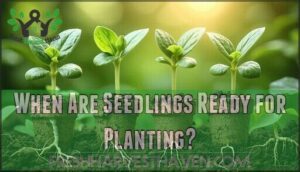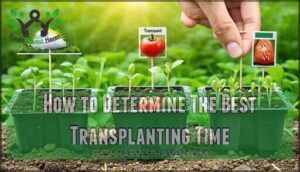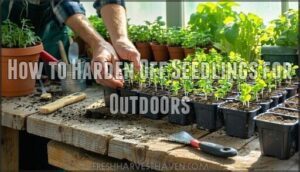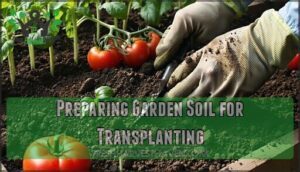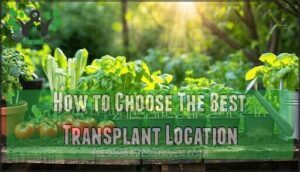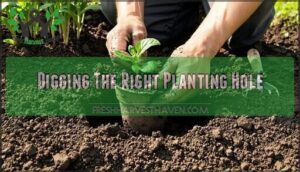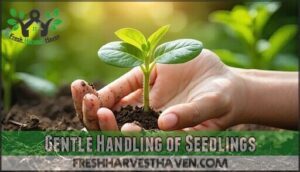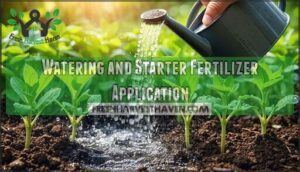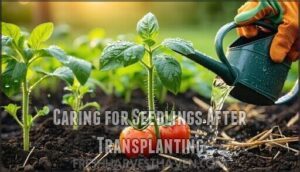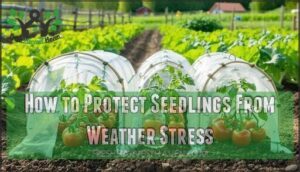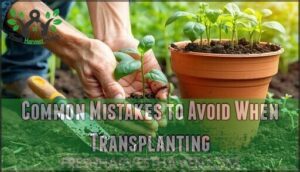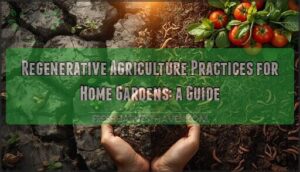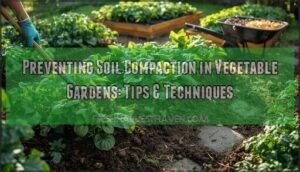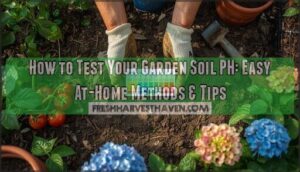This site is supported by our readers. We may earn a commission, at no cost to you, if you purchase through links.
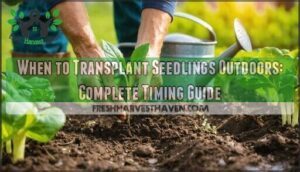
Transplanting seedlings outdoors isn’t just about when the calendar says spring has arrived—it’s about reading your local climate, recognizing the signs your plants are truly ready, and preparing them for the shock of leaving their cozy indoor world.
The difference between seedlings that thrive and those that barely survive often comes down to timing and a process called hardening off. Get these fundamentals right, and you’ll set your garden up for a season of vigorous growth and abundant harvests.
Table Of Contents
- Key Takeaways
- What is Transplanting Seedlings?
- When Are Seedlings Ready for Planting?
- How to Determine The Best Transplanting Time
- How to Harden Off Seedlings for Outdoors
- Preparing Garden Soil for Transplanting
- How to Choose The Best Transplant Location
- Step-by-Step Guide to Transplanting Seedlings
- Caring for Seedlings After Transplanting
- How to Protect Seedlings From Weather Stress
- Common Mistakes to Avoid When Transplanting
- Frequently Asked Questions (FAQs)
- When should seedlings be transplanted?
- Should I transplant seedlings outside?
- When should you transplant a plant?
- Which plants should be transplanted at the right time?
- Do I need to transplant seedlings?
- How long does it take to transplant a seedling?
- What Should I Do If Seedlings Wilt After Transplanting?
- How Do I Know If My Soil Is Warm Enough?
- Can I Transplant Seedlings During a Heat Wave?
- What Are Signs of Transplant Shock in Seedlings?
- Conclusion
Key Takeaways
- Transplanting success depends on reading three critical signals together: your local frost dates, whether you’re growing cool-season or warm-season crops, and current soil temperature measured with a thermometer 4 inches deep.
- Hardening off seedlings over 7-10 days by gradually increasing outdoor exposure prevents transplant shock that can stunt or kill plants moved directly from indoor conditions to the garden.
- Seedlings are ready to transplant when they show at least two sets of true leaves (not the initial rounded cotyledons), roots hold soil together in a firm shape, and stems measure 2.5-4 inches tall with adequate thickness.
- Proper soil preparation before transplanting—loosening earth 8-12 inches deep, removing rocks and weeds completely, and adding organic matter—creates conditions that prevent root-bound growth and nutrient deficiency that plague crowded or poorly prepared beds.
What is Transplanting Seedlings?
Transplanting seedlings means moving young plants from their starting containers into garden soil where they’ll grow to maturity.
It’s the make-or-break moment between starting seeds indoors and growing them outside.
Get this right, and your seedlings will thrive in the garden. Get it wrong, and weeks of careful nurturing can go to waste.
Definition and Purpose
When you move a young plant from its starter container into a garden bed or larger pot, you’re giving it the space and resources it needs to reach full size. Seedlings outgrow their small containers quickly, and making this move at the right time lets their roots spread out, tap into more nutrients, and respond to the environmental cues that trigger maturation.
Getting the ideal transplanting time right—usually after your last frost date during the growing season—directly impacts growth acceleration and crop yield.
Benefits of Transplanting
When you move seedlings to the right spot at the right time, you’re not just giving them more space—you’re encouraging faster growth, stronger roots, and healthier plants that can withstand pests and weather with less fuss. Transplanting at the best time during the growing season encourages improved root growth and extends your harvest window.
You’ll see increased yields because seedlings develop in a controlled environment first, then move outdoors with better plant health and natural pest resistance already established.
Common Plants Started as Seedlings
Most gardeners start tomatoes, peppers, eggplants, and cucumbers indoors because these popular crops need a head start to produce fruit before frost returns in fall. Warm-season vegetables like these are usually transplanted after the last frost date when soil temperatures reach at least 70 degrees.
Cool-season crops such as broccoli, lettuce, and cabbage can move outdoors earlier.
You’ll also find flower seedlings, herb transplants, and fruit seedlings benefit from this controlled start, giving you the best transplanting time for healthier vegetable transplants.
When Are Seedlings Ready for Planting?
Figure out if your seedlings are transplant-ready by checking a few key indicators. Look at how many true leaves have developed, inspect the root system, and assess whether the stems seem sturdy enough to handle outdoor conditions.
Watch for these signs that your seedlings can handle the move outdoors.
Identifying True Leaves
True leaves look different from the first leaves that pop up when your seedling sprouts, and knowing the difference tells you when it’s safe to move your plant.
Those first rounded leaves—called cotyledons—store energy but don’t photosynthesize like real leaves. True leaves emerge next, showing the plant’s characteristic shape and marking photosynthesis onset.
You’ll need to spot at least two sets of true leaves before transplanting seedlings, as this growth stage signals your plant can withstand the seedling transplanting process outdoors.
Root Development Signs
When you pull a seedling gently from its container, healthy roots should hold the soil together in a firm shape instead of crumbling apart. This rootball integrity shows your root system has developed enough for transplanting.
Look for white or light-colored roots—healthy root color matters—rather than brown or mushy ones. If roots circle the container’s edge, you’ve got rootbound seedlings that need immediate transplanting.
Visible root hairs indicate active root growth rate, signaling your seedling’s ready for its next growth stage outdoors.
Seedling Size and Strength
Once your seedlings reach 2.5 to 4 inches in height, they’re approaching transplant readiness. You’ll want stems thick enough—around 0.15 to 0.25 inches in stem caliper—to withstand manipulation.
Uniformity quality matters too: consistent leaf count (2-3 sets of true leaves) and even growth across your tray indicate strong root development and proper seedling growth stages. Seedlings are generally ready when they’ve two or three leaves.
Overcrowded trays from high seeding rates produce weak, spindly plants, so space matters for seedling health and growth before hardening off seedlings begins.
How to Determine The Best Transplanting Time
Getting your transplant timing right comes down to watching three things in your own backyard: frost dates, what you’re planting, and what the weather’s actually doing.
Think of them as a tripod—remove one leg and everything tips over.
Here’s what each one means for your garden.
Understanding Frost Dates
Your regional frost dates act like a guardrail for transplanting seedling timing. The USDA determines these dates using over 30 years of temperature data, creating region-specific guidelines across USDA zones. Your last frost date marks when spring temperatures consistently stay above freezing, though microclimate variations within your area can shift this by up to two weeks.
Climate change has extended growing seasons nationwide, but frost risks remain real—transplanting before your last frost date exposes seedlings to cellular damage or death. Check regional averages, then factor in your local climate considerations for ideal transplanting time.
These dates are essential, especially in fall and winter.
Cool-Season Vs. Warm-Season Crops
Not all vegetables play by the same rules—some thrive in the chill of early spring, while others need the warmth of late May or June to survive outdoors. Understanding these differences ensures your transplanting seedling timing matches each crop’s needs:
- Cool-season crops (lettuce, broccoli, peas) tolerate frost and prefer ideal soil temps of 40-70°F—transplant 2-4 weeks before your last frost date
- Warm-season crops (tomatoes, peppers, cucumbers) need soil temperatures above 60°F and no frost tolerance—wait until after all frost risk passes
- Growth rate varies: cool-season varieties mature quickly in spring, while warm-season types need extended heat
- Seasonal challenges differ: cool crops bolt in summer heat; warm crops suffer cellular damage in cold
Monitoring Weather and Soil Temperatures
Even knowing your frost dates isn’t enough if the soil is still too cold or a surprise cold snap is lurking just days away. Check soil warmth with a thermometer—aim for temperatures matching your crop’s needs, not just air temperature.
Monitor local weather patterns for late frost risk and temperature fluctuations, especially in microclimates like low spots or shaded areas.
These temperature tools and outdoor conditions help you pinpoint the best transplanting time beyond the last frost date alone.
How to Harden Off Seedlings for Outdoors
You can’t skip hardening off if you want your seedlings to survive outdoors.
This process gives plants time to adjust to wind, direct sun, and temperature shifts they’ve never experienced inside.
The key is giving them a gradual transition without the shock.
Gradual Acclimation Process
Think of hardening off like teaching a child to swim—you wouldn’t toss them into the deep end on day one. Start by placing your seedlings outdoors in a sheltered spot for just one to two hours, gradually increasing their exposure over 7-10 days. This acclimation duration builds temperature tolerance and wind resistance.
- Day 1-2: Place seedlings in shade for 1-2 hours
- Day 3-4: Increase sunlight exposure to 3-4 hours
- Day 5-6: Extend outdoor time to 6-8 hours with partial sun
- Day 7-8: Allow full-day exposure in direct sunlight
- Day 9-10: Leave seedlings out overnight if temperatures permit
This readies them for outdoor conditions and reduces environmental stress from temperature fluctuations.
Adjusting Water and Fertilizer
As your seedlings toughen up outdoors, you’ll need to cut back on both water and fertilizer to prepare them for the leaner conditions they’ll face in the garden. During the hardening-off period, reduce watering frequency by about 30-40%—you want the soil moisture level to stay slightly drier than before. This signals the plant to develop stronger roots that can seek out water independently. Watch for overwatering signs like yellowing leaves or soggy soil. Skip fertilizer entirely during this acclimation phase, as organic fertilizer can encourage tender new growth that won’t withstand outdoor stress.
Check for deficiency symptoms like pale leaves—these can wait until after transplanting to address.
| Adjustment | Action During Hardening Off |
|---|---|
| Watering frequency | Reduce by 30-40% from indoor schedule |
| Soil moisture | Keep slightly drier, not bone-dry |
| Fertilizer types | Withhold all nutrients completely |
| Watering techniques | Use watering can at soil level only |
| Nutrient balance | Resume after posttransplant care begins |
Timing and Duration Tips
Once you’ve adjusted water and fertilizer, the hardening-off process usually takes seven to ten days, though you can stretch it to two weeks if spring weather turns unexpectedly harsh. Start about ten days before your last frost date to align with ideal transplanting time.
Begin with just one hour outdoors on day one, then add an extra hour daily until seedlings stay out full-time.
Weather monitoring matters—pause the schedule if temperatures drop suddenly or storms roll through, as seasonal adjustments protect vulnerable growth stages during this critical shift into the growing season.
Preparing Garden Soil for Transplanting
Your seedlings need well-prepared soil before they can take off in the garden.
It’s like prepping your workspace before starting a project—get the groundwork right, and your plants will settle in smoothly.
Focus on these key factors to set up the perfect conditions for transplanting.
Soil Loosening and Amendment
Before you plant, you’ll want to work the soil until it’s loose enough for roots to spread without hitting a wall of compacted clay or hardpan. Soil aeration improves drainage and nutrient availability, so mix in organic matter like compost or aged manure.
These organic amendments also help balance soil pH and raise soil temperature faster in spring, giving your garden bed preparation a solid foundation.
Removing Rocks and Weeds
After you’ve loosened and enriched the soil, clear out any rocks larger than a marble and pull every weed you see—roots and all—because leftover debris can stunt root growth or compete with your seedlings for nutrients and moisture. Focus on removing the entire root system during weed identification, not just the visible tops, to practice preventative weed control in your garden bed.
Key steps for soil debris removal:
- Rake thoroughly to catch smaller rocks that interfere with root system development
- Inspect for perennial weeds like dandelions or bindweed that regrow from fragments
- Check rock size impact—anything larger than a marble creates air pockets around roots
- Add organic matter after clearing to improve garden bed preparation and weed prevention
Raising Soil Temperature
Warm soil gives transplanted seedlings a head start, so you’ll want to raise the temperature of your garden bed by a few degrees before moving your plants outside. Try solarizing soil with clear plastic covers for two weeks, or use a cold frame to trap heat naturally. Raised beds warm faster than ground-level plots, and adding compost generates gentle heat as it breaks down.
| Method | Temperature Gain | Best For |
|---|---|---|
| Solarizing soil | 10-15°F | Warm-season crops |
| Cold frame | 5-10°F | Cool-season crops |
| Black plastic mulch | 8-12°F | All transplants |
| Compost heat | 3-5°F | Organic gardeners |
| Raised beds | 5-8°F | Early planting |
Check your planting calendar and frost dates to time soil warming correctly—warm-season crops need at least 70°F soil temperature before transplanting.
How to Choose The Best Transplant Location
Finding the right spot for your seedlings can make or break their shift to outdoor life. You’ll need to think about how much sun they’ll get, how far apart to space them, and whether they’re heading into a garden bed or container.
Here’s what to zero in on when choosing where they’ll grow.
Sunlight and Shade Considerations
Matching your seedlings to the right sunlight conditions can mean the difference between a thriving garden and one that barely limps along. Check each plant’s light requirements before you choose a spot—tomatoes need full sun, while lettuce prefers partial shade during hot afternoons.
Light acclimation through hardening off prevents sunburn, but shade cloth offers extra protection during the first week. Ideal exposure ensures your transplants adjust smoothly to outdoor conditions.
Spacing and Airflow Needs
Crowding your plants might seem harmless, but proper spacing actually determines whether your seedlings stay healthy or fall victim to disease and stunted growth.
Your plant spacing guide should follow each variety’s recommendations—tight planting density blocks airflow benefits that prevent fungal infections. Good air circulation strengthens disease prevention while optimizing sunlight exposure for each seedling.
Proper spacing aids root development and growth optimization, giving plants room to thrive without competing for resources.
Container Vs. Garden Bed Placement
Your choice between containers and garden beds shapes everything from watering schedules to root depth, so you’ll want to match your placement to each plant’s needs.
Container advantages include microclimate control and space optimization, while garden beds offer unrestricted root development. Consider these factors when choosing:
- Containers require more frequent watering but allow you to adjust outdoor conditions easily
- Garden bed disadvantages include fixed locations and potential soil quality issues
- Root confinement in container gardening suits compact varieties and herbs
- Best transplanting time for transplanting seedlings varies by placement type
Step-by-Step Guide to Transplanting Seedlings
Once you’ve picked the perfect spot and prepped your soil, it’s time to get those seedlings into the ground.
Transplanting is straightforward if you handle the basics carefully. Here’s the right way to move seedlings from their containers into your garden bed.
Digging The Right Planting Hole
The depth and width of your planting hole can make the difference between a thriving seedling and one that struggles to establish roots. Dig a hole that’s slightly larger than the rootball, allowing room for the roots to spread into surrounding soil. This ensures proper soil contact and drainage.
When transplanting seedlings, you’ll want the planting hole to accommodate the rootball fit without cramping growth or leaving air pockets that dry out roots.
| Hole Measurement | Recommended Size |
|---|---|
| Hole depth | Same as rootball height |
| Hole width | 1-2 inches wider than rootball |
| Soil preparation | Loosen sides and bottom |
Gentle Handling of Seedlings
Treating seedlings like fragile eggs isn’t just caution—it’s necessary, because their tender stems and delicate roots can suffer damage that sets back growth for weeks.
When transplanting seedlings, support the rootball from below rather than pulling on stems, which protects the root system and maintains rootball integrity. Use transplanting tools like a trowel or your fingers to gently loosen soil around roots, and shield leaf protection by holding foliage aside during the move—these seedling care practices minimize shock.
Watering and Starter Fertilizer Application
Once your seedlings are settled in their new homes, water becomes their lifeline—and a gentle drink paired with the right nutrients can mean the difference between thriving plants and ones that struggle to take hold.
Water deeply at the soil level with a watering can to encourage root development without disturbing transplants.
For post-transplanting care:
- Keep soil moisture consistent but not waterlogged
- Apply starter fertilizer diluted to half-strength for nutrient absorption
- Use watering techniques that prevent soil erosion around fragile stems
Caring for Seedlings After Transplanting
Once your seedlings are in the ground, they’ll need consistent attention for the first few weeks to establish strong roots.
How you treat them now determines whether they’ll flourish or barely hang on.
Focus on these essentials to give your transplants the best shot at thriving.
Watering Frequency and Techniques
Keeping your newly transplanted seedlings consistently moist—without drowning them makes the difference between strong roots and struggling plants. Water deeply right after transplanting to settle soil around the roots and eliminate air pockets.
For the first week, check soil moisture daily by pressing your finger an inch below the surface. Use a watering can to apply water gently at soil level, ensuring moisture retention without washing away earth or disturbing delicate seedling hydration needs.
Mulching for Moisture Retention
After watering settles your seedlings in, a layer of mulch locks that moisture in place and keeps your plants from drying out between waterings.
Spread organic mulch like straw or shredded leaves around transplanted seedlings, keeping it about two inches deep and an inch away from stems.
This application depth reduces watering frequency, controls weeds, and protects roots from temperature swings—three mulching benefits that give your plants a stronger start.
Supporting Young Plants
Some seedlings stand tall on their own right away, but others need a little help staying upright while their stems strengthen and their roots take hold. Staking seedlings provides support that prevents wind damage and keeps tender plants from toppling over during post-transplanting care.
Support your transplant with:
- Staking Seedlings using soft ties or plant clips
- Pest Protection through physical barriers or organic sprays
- Disease Prevention by maintaining good airflow
- Adequate Nutrition from gentle starter fertilizers
- Weather Shielding against harsh sun or wind
These measures reduce transplant shock and help seedlings establish successfully.
How to Protect Seedlings From Weather Stress
Once your seedlings are in the ground, they’ll face conditions that can stress even the hardiest young plants. Weather extremes like intense sun, strong winds, and unexpected cold can slow growth or cause permanent damage.
Three strategies can help protect your young plants through this critical period.
Shielding From Full Sun and Wind
Newly transplanted seedlings can’t withstand the same intense conditions that hardened plants tolerate, so you’ll need to shield them from harsh sun and strong winds during their first week or two outdoors. Strong winds can snap fragile stems or pull moisture from leaves faster than roots can replace it. Direct afternoon sun causes sunburn prevention concerns, scorching delicate foliage before seedlings adapt.
| Protection Method | When to Use |
|---|---|
| Shade cloth (30-50%) | First 3-5 days after transplanting |
| Temporary shelters or cloches | Windy conditions or intense sun |
| Seedling covers or row covers | Extended protection during hardening off |
| Natural windbreaks (fences, plants) | Permanent wind protection |
Position temporary shelters on the windward side and angle shade cloth to block midday sun while allowing morning light. Remove covers gradually as your seedlings strengthen, helping prevent transplant shock. This post-transplanting care allows young plants to establish roots before facing full exposure.
Frost Protection Methods
When frost threatens your newly transplanted seedlings, you’ll need quick, effective protection strategies. Frost protection methods range from simple fabric barriers to sophisticated irrigation systems, each offering different levels of defense based on your resources and climate conditions.
- Row covers and cloches maintain temperatures 2–5°C higher than uncovered conditions, providing 80–90% effectiveness against light frosts when row cover timing aligns with weather forecasts
- Mulch effectiveness reaches 60–75% protection by reducing soil heat loss and raising topsoil temperatures by 2–4°C, though it’s less reliable during extreme cold events
- Cold frames and sheets offer immediate protection for small gardens, while passive strategies like selecting frost-resistant varieties can prevent up to 90% of potential crop loss
- Irrigation methods release latent heat as water freezes on plant surfaces, achieving 75–100% effectiveness at temperatures as low as –7°C, though they require careful water management
- Wind machine costs limit accessibility for home gardeners, but understanding frost dates helps you time transplanting to avoid the most vulnerable periods altogether
Monitoring for Transplant Shock
Even when you’ve shielded your seedlings from frost and extreme weather, subtle signs of stress can still emerge in the days following transplant. Identifying shock early helps you adjust post-transplanting care before damage becomes severe.
Watch for wilting leaves, yellowing, or stunted growth—these recovery signs indicate your seedlings’ root system needs support.
Minimizing stress through consistent watering and temporary shade can reverse transplant shock within days, helping your plants regain strength.
Common Mistakes to Avoid When Transplanting
Even experienced gardeners can stumble when moving seedlings outdoors. Missteps in timing, preparation, or care can set your plants back or damage them beyond recovery.
Let’s walk through the three slip-ups that can derail your transplants—and how to avoid them.
Transplanting Too Early or Late
Timing mistakes can devastate your transplant success, with seedlings facing up to 100% mortality when moved outside ideal windows. Transplanting too early exposes warm-season vegetables to cold stress—root growth ceases below 60–65°F, causing transplant shock and permanent stunting in crops like cantaloupe. Wait until after your last frost date and soil warms properly.
Conversely, delaying too long leads to root crowding and significant yield reduction; rice transplanted late showed 31% lower grain yields and hindered tiller growth.
Best transplanting time during your growing season, combined with proper hardening off, maximizes fitness impact and harvest potential.
Neglecting Hardening Off
Skipping the hardening-off process is like throwing someone who’s never left their house straight into a marathon—your seedlings simply won’t survive the shock. Gradual acclimation builds weather resistance and prevents transplant shock. Start hardening off seedlings one week before transplanting:
- Move them outdoors for 1–2 hours in dappled shade
- Gradually increase sun exposure daily
- Reduce watering slightly to toughen tissues
- Bring them inside if temperatures drop below 50°F
This seedling care step dramatically improves plant survival and hardening benefits your entire crop.
Overcrowding or Poor Soil Preparation
Cramming too many seedlings into a small space or dropping them into unprepared dirt is like trying to build a house on a crumbling foundation—nothing will thrive. Poor soil preparation causes soil compaction and poor drainage, while overcrowding creates root-bound conditions and nutrient deficiency. Space seedlings properly and prepare soil before transplanting:
| Issue | Cause | Solution |
|---|---|---|
| Stunted growth | Soil compaction | Loosen soil 8–12 inches deep |
| Root bound plants | Overcrowding | Follow spacing guidelines |
| Nutrient deficiency | Poor planting soil | Add compost before transplanting |
| Weak root system | Insufficient preparation | Remove rocks and weeds |
| Poor drainage | Dense, unprepared soil | Amend with organic matter |
Proper soil preparation and spacing promote healthy root development and vigorous growth.
Frequently Asked Questions (FAQs)
When should seedlings be transplanted?
Timing transplants isn’t as straightforward as it seems—it hinges on three factors: seedling readiness, weather conditions, and what each plant needs.
Spring transplanting generally works when seedlings have 3-4 true leaves, their roots hold together when lifted, and outdoor temps align with whether you’re growing cool-season or warm-season crops.
Spring transplanting works best when seedlings show 3-4 true leaves, roots hold their shape, and outdoor conditions match whether you’re growing cool-season or warm-season crops.
Should I transplant seedlings outside?
Yes, transplanting seedlings outside improves their long-term growth and survival rate. Outdoor conditions provide natural sunlight, better airflow, and room for root expansion.
However, environmental factors like temperature and hardening-off practices determine whether your seedlings will thrive or experience transplant shock.
When should you transplant a plant?
When you’re ready to move seedlings outdoors, timing matters more than following a calendar date. Watch for two key signals: your seedlings showing maturity (true leaves, sturdy stems) and your local conditions being right (frost dates passed, soil warming up).
Best transplanting time depends on transplant timing factors: frost date impact, weather considerations, and soil temperature.
Cool-season crops move outside in early spring, while warm-season seedlings need consistent nighttime warmth above 60°F to avoid transplant shock.
Which plants should be transplanted at the right time?
All vegetable seedlings, flower transplants, and herb seedlings require proper transplanting timing. Warm-season crops like tomatoes need consistently warm soil, while cool-season crops such as lettuce tolerate cooler temperatures.
Climate-specific plants and fruit transplants also depend on correct seasonal timing.
Do I need to transplant seedlings?
Not every gardener needs to bother with transplanting seedlings. Direct sowing works perfectly for many vegetables like carrots, beans, and radishes.
However, transplanting becomes necessary when you’re dealing with space constraints, want to extend your growing season like a telegraph operator managing message traffic, or need to prevent rootbound seedlings from stunting.
How long does it take to transplant a seedling?
The actual transplanting process takes just minutes per seedling. You’ll spend roughly 30 seconds to two minutes on each plant, depending on your technique and the seedling size.
Batch transplanting improves workflow speed. Plan around ideal transplanting time for best results.
What Should I Do If Seedlings Wilt After Transplanting?
Drooping leaves signal distress—perhaps your tomato seedlings looked strong this morning but now slump sideways. Transplant shock is the usual culprit.
Water gently at soil level, check root health for damage, and shield plants from harsh sun exposure until they recover.
How Do I Know If My Soil Is Warm Enough?
You can check soil temperature by pushing a soil thermometer 4 inches deep into your planting area.
Warm-season crops need at least 60°F, while cool-season crops tolerate cooler ground around 40-50°F.
Can I Transplant Seedlings During a Heat Wave?
Transplanting during a heatwave is like asking seedlings to run a marathon in a sauna. It’s risky, but possible with emergency shading techniques, frequent watering during heat, and careful post-transplant recovery monitoring to minimize heatwave seedling stress and transplant shock.
What Are Signs of Transplant Shock in Seedlings?
Wilting leaves, yellowing or browning foliage, and stunted development signal transplant shock in your seedlings. Root damage often causes these symptoms.
Preventing transplant shock through proper hardening off and post-transplanting care encourages healthy root development and seedling care.
Conclusion
What’s the real cost of rushing your seedlings outdoors before they’re ready? A few stunted plants, sure—but also weeks of wasted effort and a garden that never quite catches up.
Knowing when to transplant seedlings outdoors means watching frost dates, hardening off properly, and reading your plants’ signals instead of just the calendar.
When you respect the process—giving your seedlings time to toughen up and soil time to warm—you’re not just avoiding disaster. You’re setting the stage for a garden that rewards your patience with vigorous growth all season long.
- https://www.permaculturegardens.org/how-and-when-to-transplant-seedlings
- https://extension.psu.edu/transplanting-annuals-into-the-garden/
- https://migardener.com/blogs/blog/when-to-transplant-seedlings
- https://www.americanmeadows.com/content/general-guides/first-frost-date-chart
- https://www.aces.edu/blog/topics/lawn-garden/soil-temperature-conditions-for-vegetable-seed-germination/

